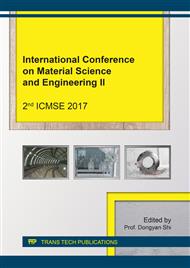[1]
U. Lucia, Overview on fuel cells. Renew. Sustain. Energy Rev. 30 (2014) 164-169.
Google Scholar
[2]
C. Wang, et al., Multimetallic Au/FePt3 nanoparticles as highly durable electrocatalyst. Nano Lett. 11(3) (2011) 919-926.
Google Scholar
[3]
Y. J. Wang, D. P. Wilkinson, and J. Zhang, Noncarbon support materials for polymer electrolyte membrane fuel cell electrocatalysts. Chem. Rev. 111(12) (2011) 7625-7651.
DOI: 10.1021/cr100060r
Google Scholar
[4]
J. Parrondo, et al., Platinum supported on titanium-ruthenium oxide is a remarkably stable electrocatayst for hydrogen fuel cell vehicles. Proc. Nat. Acad. Sci. U. S. A. 111(1) (2014) 45-50.
DOI: 10.1073/pnas.1319663111
Google Scholar
[5]
V. T. Ho, et al., Robust non-carbon Ti0. 7Ru0. 3O2 support with co-catalytic functionality for Pt: enhances catalytic activity and durability for fuel cells. Energ. Envir. Sci. 4(10) (2011) 4194.
DOI: 10.1039/c1ee01522b
Google Scholar
[6]
V. T. Ho, et al., Nanostructured Ti(0. 7)Mo(0. 3)O2 support enhances electron transfer to Pt: high-performance catalyst for oxygen reduction reaction. J. Am. Chem. Soc. 133(30) (2011) 11716-11724.
DOI: 10.1021/ja2039562
Google Scholar
[7]
D. A. Stevens, et al., Ex Situ and In Situ Stability Studies of PEMFC Catalysts. J. Electrochem. Soc. 152(12) (2005) A2309.
DOI: 10.1149/1.2097361
Google Scholar
[8]
R. Kou, et al., Stabilization of Electrocatalytic Metal Nanoparticles at Metal−Metal Oxide−Graphene Triple Junction Points. J. Am. Chem. Soc. 133(8) (2011) 2541-2547.
DOI: 10.1021/ja107719u
Google Scholar
[9]
M. M. Shaijumon, S. Ramaprabhu, and N. Rajalakshmi, Platinum/multiwalled carbon nanotubes-platinum/carbon composites as electrocatalysts for oxygen reduction reaction in proton exchange membrane fuel cell. Appl. Phys. Lett. 88(25) (2006) 253105.
DOI: 10.1063/1.2214139
Google Scholar
[10]
S. Ghosh, S. Mondal, and C. Retna Raj, Carbon nanotube-supported dendritic Pt-on-Pd nanostructures: growth mechanism and electrocatalytic activity towards oxygen reduction reaction. J. Mater. Chem. A, 2(7) (2014) 2233-2239.
DOI: 10.1039/c3ta13954a
Google Scholar
[11]
Y. Shao, et al., Novel catalyst support materials for PEMfuelcells: current status and future prospects. J. Mater. Chem. 19(1) (2009) 46-59.
DOI: 10.1039/b808370c
Google Scholar
[12]
S. Y. Huang, et al., Development of a Titanium Dioxide-Supported Platinum Catalyst with Ultrahigh Stability for Polymer Electrolyte Membrane Fuel Cell Applications. J. Am. Chem. Soc. 131(39) (2009) 13898-13899.
DOI: 10.1021/ja904810h
Google Scholar
[13]
P. Dhanasekaran, et al., Rutile TiO2 Supported Pt as Stable Electrocatalyst for Improved Oxygen Reduction Reaction and Durability in Polymer Electrolyte Fuel Cells. Electrocatal. 7(6) (2016) 495-506.
DOI: 10.1007/s12678-016-0329-7
Google Scholar
[14]
P. Mazúr, et al., Non-conductive TiO2 as the anode catalyst support for PEM water electrolysis. Int. J. Hydr. Energ. 37(17) (2012) 12081-12088.
DOI: 10.1016/j.ijhydene.2012.05.129
Google Scholar
[15]
C. V. Subban, et al., Sol−Gel Synthesis, Electrochemical Characterization, and Stability Testing of Ti0. 7W0. 3O2 Nanoparticles for Catalyst Support Applications in Proton-Exchange Membrane Fuel Cells. J. Am. Chem. Soc. 132(49) (2010).
DOI: 10.1021/ja1074163
Google Scholar
[16]
I. Jang, I. Hwang, and Y. Tak, Attenuated degradation of a PEMFC cathode during fuel starvation by using carbon-supported IrO2. Electrochim. Acta, 90 (2013) 148-156.
DOI: 10.1016/j.electacta.2012.12.034
Google Scholar
[17]
E. Antolini, Iridium As Catalyst and Cocatalyst for Oxygen Evolution/Reduction in Acidic Polymer Electrolyte Membrane Electrolyzers and Fuel Cells. ACS Catal. 4(5) (2014) 1426-1440.
DOI: 10.1021/cs4011875
Google Scholar
[18]
Y. Zheng, et al., Hydrothermal Preparation of Nanosized Brookite Powders. J. Am. Ceram. Soc. 83(10) (2000) 2634-2636.
Google Scholar
[19]
S. Bakardjieva, et al., Transformation of brookite-type TiO2 nanocrystals to rutile: correlation between microstructure and photoactivity. J. Mater. Chem. 16(18) (2006) 1709.
DOI: 10.1039/b514632a
Google Scholar
[20]
K. Yanagisawa, and J. Ovenstone, Crystallization of Anatase from Amorphous Titania Using the Hydrothermal Technique: Effects of Starting Material and Temperature. J. Phys. Chem. B, 103(37) (1999) 7781-7787.
DOI: 10.1021/jp990521c
Google Scholar


